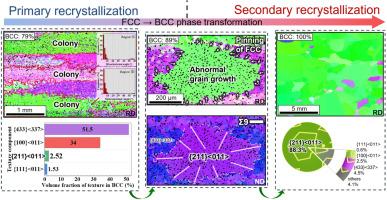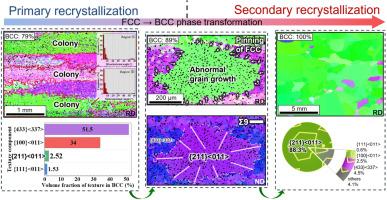多晶FeMnAlNi形状记忆合金片的织构演化
IF 9.3
1区 材料科学
Q1 MATERIALS SCIENCE, MULTIDISCIPLINARY
引用次数: 0
摘要
对于多晶铁基形状记忆合金来说,晶体织构对于消除晶界约束和优化力学性能(如超弹性和延展性)至关重要。本研究采用电子背散射衍射技术系统研究了一种多晶FeMnAlNi合金在冷轧、一次再结晶和二次再结晶过程中的织构演变。从体心立方(BCC) + 面心立方(FCC)两相组织开始,94.1%冷轧试样表现为FCC相为主,具有较强的黄铜织构成分,BCC相体积分数较少。初次再结晶退火后,生长的BCC晶粒与相邻FCC晶粒的取向受Kurdjumov-Sachs取向关系支配。这些BCC晶粒主要表现为{433}<;337>;和{100}<;011>;取向。当温度超过~ 1120℃时,小部分{211}<;011>;取向BCC晶粒在FCC相溶解的同时出现了异常晶粒长大。此外,群体结构和Σ9边界可能导致了异常的晶界迁移速率,最终在BCC单相组织中产生明显的{211}<;011>;织构。本文章由计算机程序翻译,如有差异,请以英文原文为准。


Texture evolution in polycrystalline FeMnAlNi shape-memory alloy sheets
For polycrystalline Fe-based shape-memory alloys, the crystallographic texture is critical for relieving grain boundary constraints and optimizing mechanical properties, such as superelasticity and ductility. In this study, the texture evolution in a polycrystalline FeMnAlNi alloy subjected to cold rolling, primary recrystallization, and secondary recrystallization was systematically investigated using electron backscatter diffraction. Starting from a body-centered cubic (BCC) + face-centered cubic (FCC) two-phase microstructure, the 94.1 % cold-rolled sample exhibited a predominantly FCC phase with a strong Brass texture component accompanied by a minor volume fraction of the BCC phase. After primary recrystallization annealing, the orientations of the grown BCC grains were governed by the Kurdjumov–Sachs orientation relationship with the adjacent FCC grains. These BCC grains predominantly exhibited {433}<337> and {100}<011> orientations. When the temperature exceeded ∼1120 °C, abnormal grain growth of a small fraction of {211}<011>-oriented BCC grains occurred concurrently with the dissolution of the FCC phase. Furthermore, the colonial structure and Σ9 boundary likely contributed to the exceptional grain boundary migration rate, ultimately yielding a pronounced {211}<011> texture in the BCC single-phase microstructure.
求助全文
通过发布文献求助,成功后即可免费获取论文全文。
去求助
来源期刊

Acta Materialia
工程技术-材料科学:综合
CiteScore
16.10
自引率
8.50%
发文量
801
审稿时长
53 days
期刊介绍:
Acta Materialia serves as a platform for publishing full-length, original papers and commissioned overviews that contribute to a profound understanding of the correlation between the processing, structure, and properties of inorganic materials. The journal seeks papers with high impact potential or those that significantly propel the field forward. The scope includes the atomic and molecular arrangements, chemical and electronic structures, and microstructure of materials, focusing on their mechanical or functional behavior across all length scales, including nanostructures.
 求助内容:
求助内容: 应助结果提醒方式:
应助结果提醒方式:


